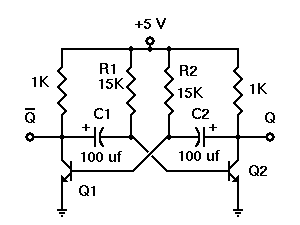
How does LED Flashes One by One in my Project Some Queries

A project called LED Flasher that sequentially flashes LEDs one by one. There is a query regarding the project, and any simple explanation would be greatly appreciated. A reference image or a link can be used for additional context.
The LED Flasher project is designed to create a visual effect by illuminating a series of light-emitting diodes (LEDs) in a sequential manner. This type of circuit is often utilized in decorative lighting, signaling devices, and educational demonstrations of electronic principles.
The core of this project typically involves a microcontroller or a simple timer circuit that controls the timing and order of the LED activation. A common choice for such a project is the use of a 555 timer IC configured in astable mode, which generates a continuous square wave output. This output can be fed into a series of transistors, each connected to an individual LED.
The circuit may include the following key components:
1. **Microcontroller or Timer IC**: This component serves as the brain of the circuit. If using a microcontroller like an Arduino, it can be programmed to control the timing and sequence of LED activation through digital output pins. Alternatively, a 555 timer can be used for simpler applications.
2. **Resistors**: These are used to limit the current flowing through the LEDs to prevent them from burning out. The value of the resistors can be calculated using Ohm's law based on the forward voltage and current rating of the LEDs.
3. **Transistors**: If the circuit uses a microcontroller, transistors may be employed as switches to drive the LEDs. This is particularly useful when the total current required by the LEDs exceeds the output current capacity of the microcontroller pins.
4. **Power Supply**: A suitable power supply is essential to provide the necessary voltage and current for the circuit operation. This could be a battery or a DC power source, depending on the application.
5. **LEDs**: The choice of LEDs can vary based on the desired visual effect. Different colors can be used, and the arrangement can affect the overall aesthetic of the flashing sequence.
The operation of the LED Flasher can be summarized as follows: the microcontroller or timer generates a signal that turns on one LED at a time in a predetermined sequence. The timing of each LED activation can be adjusted to create different flashing patterns, such as a simple chase effect or more complex animations.
In conclusion, the LED Flasher project serves as an excellent introduction to basic electronic components and circuit design, allowing users to explore concepts such as timing, sequencing, and current control in a practical and visually appealing way.A project called LED Flasher which Flashes LED`s one by one . but I have following Query about my project . if anyone can explain me it in simple words it will be great help for me . one can use Below image for reference or use this link 🔗 External reference
The LED Flasher project is designed to create a visual effect by illuminating a series of light-emitting diodes (LEDs) in a sequential manner. This type of circuit is often utilized in decorative lighting, signaling devices, and educational demonstrations of electronic principles.
The core of this project typically involves a microcontroller or a simple timer circuit that controls the timing and order of the LED activation. A common choice for such a project is the use of a 555 timer IC configured in astable mode, which generates a continuous square wave output. This output can be fed into a series of transistors, each connected to an individual LED.
The circuit may include the following key components:
1. **Microcontroller or Timer IC**: This component serves as the brain of the circuit. If using a microcontroller like an Arduino, it can be programmed to control the timing and sequence of LED activation through digital output pins. Alternatively, a 555 timer can be used for simpler applications.
2. **Resistors**: These are used to limit the current flowing through the LEDs to prevent them from burning out. The value of the resistors can be calculated using Ohm's law based on the forward voltage and current rating of the LEDs.
3. **Transistors**: If the circuit uses a microcontroller, transistors may be employed as switches to drive the LEDs. This is particularly useful when the total current required by the LEDs exceeds the output current capacity of the microcontroller pins.
4. **Power Supply**: A suitable power supply is essential to provide the necessary voltage and current for the circuit operation. This could be a battery or a DC power source, depending on the application.
5. **LEDs**: The choice of LEDs can vary based on the desired visual effect. Different colors can be used, and the arrangement can affect the overall aesthetic of the flashing sequence.
The operation of the LED Flasher can be summarized as follows: the microcontroller or timer generates a signal that turns on one LED at a time in a predetermined sequence. The timing of each LED activation can be adjusted to create different flashing patterns, such as a simple chase effect or more complex animations.
In conclusion, the LED Flasher project serves as an excellent introduction to basic electronic components and circuit design, allowing users to explore concepts such as timing, sequencing, and current control in a practical and visually appealing way.A project called LED Flasher which Flashes LED`s one by one . but I have following Query about my project . if anyone can explain me it in simple words it will be great help for me . one can use Below image for reference or use this link 🔗 External reference





